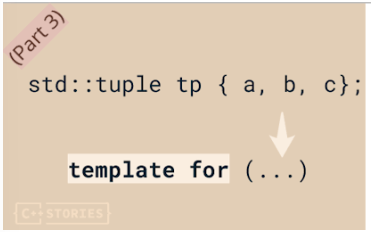How to Iterate through std::tuple: C++26 Packs and Expansion Statements -- Bartlomiej Filipek
 In this final part of the tuple-iteration mini-series, we move beyond C++20 and C++23 techniques to explore how C++26 finally brings first-class language support for compile-time iteration. With structured binding packs (P1061) and expansion statements (P1306), what once required clever template tricks can now be written in clean, expressive, modern C++.
In this final part of the tuple-iteration mini-series, we move beyond C++20 and C++23 techniques to explore how C++26 finally brings first-class language support for compile-time iteration. With structured binding packs (P1061) and expansion statements (P1306), what once required clever template tricks can now be written in clean, expressive, modern C++.
C++ Templates: How to Iterate through std::tuple: C++26 Packs and Expansion Statements
by Bartlomiej Filipek
From the article:
In part 1 of this mini-series, we looked at the basics of iterating over a
std::tupleusingindex_sequenceand fold expressions. In part 2, we simplified things withstd::applyand even created helpers likefor_each_tupleandtransform_tuple.So far, we used C++ features up to C++20/23… but now, in C++26, we finally get language-level tools that make tuple iteration straightforward and expressive. In this article, we’ll explore two new techniques:

 std::format allows us to format values quickly and safely. Spencer Collyer demonstrates how to provide formatting for a simple user-defined class.
std::format allows us to format values quickly and safely. Spencer Collyer demonstrates how to provide formatting for a simple user-defined class. Modern C++ offers elegant abstractions like std::ranges that promise cleaner, more expressive code without sacrificing speed. Yet, as with many abstractions, real-world performance can tell a more nuanced story—one that every engineer should verify through careful benchmarking.
Modern C++ offers elegant abstractions like std::ranges that promise cleaner, more expressive code without sacrificing speed. Yet, as with many abstractions, real-world performance can tell a more nuanced story—one that every engineer should verify through careful benchmarking. If you’re a regular reader of Sandor's blog, you know he's been sharing what he learned about new C++ language and library features ever since C++20. You probably also read his CppCon 2025 Trip Report. And this post is where the two come together.
If you’re a regular reader of Sandor's blog, you know he's been sharing what he learned about new C++ language and library features ever since C++20. You probably also read his CppCon 2025 Trip Report. And this post is where the two come together. In this post, we’ll take a closer look at how to extend the earlier callback wrapper mechanism to handle regular function pointers as well as member functions. Along the way, we’ll examine some of the subtleties of inferring function pointer types from callable objects—especially when lambdas with auto parameters enter the picture.
In this post, we’ll take a closer look at how to extend the earlier callback wrapper mechanism to handle regular function pointers as well as member functions. Along the way, we’ll examine some of the subtleties of inferring function pointer types from callable objects—especially when lambdas with auto parameters enter the picture. This post chronicles a month-long experiment using C++26 reflections to automate the generation of pybind11 bindings, blending the promise of modern metaprogramming with real-world complexity. It offers a candid look at what worked beautifully, what fell short, and what future language features could make reflection-driven automation even more powerful.
This post chronicles a month-long experiment using C++26 reflections to automate the generation of pybind11 bindings, blending the promise of modern metaprogramming with real-world complexity. It offers a candid look at what worked beautifully, what fell short, and what future language features could make reflection-driven automation even more powerful.